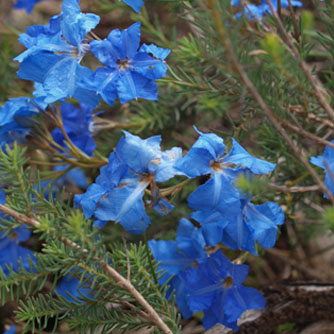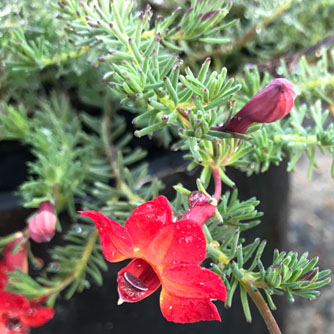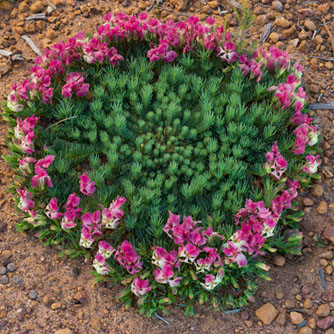Lechenaultias
BackLechenaultia are a group of small growing Western Australian natives much admired for their stunning flowers which appear in spring and summer. The two most popular types are the blue lechenaultia (Lechenaultia biloba) and the red lechenaultia (L. formosa). Despite the common names there is variability in their flower colour so you can also buy white, yellow and orange forms.
Lechenaultias can look quite delicate but in reality they are tough plants which like exposed, sunny positions and can handle light frosts. The blue and red lechenaultias are small low growing plants and look great in cottage gardens, rockeries, native gardens, pots and hanging baskets.
Sometimes these plants are labeled Leschenaultia because they were named after French botanist Jean-Baptiste Leschenault de la Tour. Currently taxonomists prefer Lechenaultia (without the s) because this was the spelling used when the plants were first named.

The vivid blue flowers of Lechenaultia biloba
How To Grow Lechenaultias
Lechenaultias are susceptible to root rot and do not like summer humidity so it is important to plant in ideal conditions for them to flourish.
Choose a full sun position in your garden that has very well drained soil and plenty of air circulation. A sandy or gravelly soil is perfect. Plants grown in heavy soils will not survive at all. If you have any doubts, mound the garden bed to increase drainage and apply gypsum to the soil before planting.
Alternatively grow in a pot using a quality native potting mix and remove any saucers to ensure good drainage. If your area experiences lots of summer rain then mix sand or perlite into the potting mix to further improve drainage.
After planting water in with OCP eco-seaweed to help them get off to a great start.
Please note that lechenaultias are naturally short-lived perennials and tend to only live a couple of years in home gardens. In humid coastal areas and regions which receive heavy summer rains it may be best to think of them as annuals.

The red flowers of Lechenaultia formosa
Fertilising & Maintenance of Lechenaultias
Apply a certified organic native fertiliser in spring and autumn and then to maintain strong and healthy growth, apply OCP eco-seaweed and OCP eco-aminogro every 2-4 weeks. This will keep the plant as vigorous and healthy as possible to help stave off fungal problems and plant decline/death.
Little pruning is usually required but if you want to maintain a denser shape then prune lightly after flowering.
Propagating Lechenaultias
Both the blue and red lechenaultias are easily propagated by semi-hardwood cuttings taken in late spring and summer. This ensures you’ll have some young vigorous plants to replace the parent plant when it dies.
Pest & Diseases of Lechenaultias
Here’s what to watch out for:
- Lechenaultias are susceptible to several diseases which cause root rot and a quick death. As mentioned above it is essential to have excellent drainage to reduce the risk of attack. Regular applications of OCP eco-seaweed and OCP eco-aminogro will build a stronger healthier plant and also help to keep diseases at bay.
- In areas with high summer humidity, fungal problems can also occur on the foliage. Improve air circulation around the plant and avoid wetting the leaves when watering. If necessary spray with an organic fungicide.
- Usually they are untroubled by pests, but if aphids, mites or caterpillars do attack, spray as necessary with OCP eco-oil or OCP eco-neem. Any scale that appears can be controlled with a horticultural oil.

The impressive wreath Lechenaultia (L. macrantha) is unfortunately very difficult to grow in the home garden


